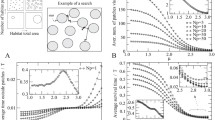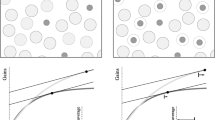Summary
Site fidelity, the tendency to return to a previously occupied location, has been observed in numerous species belonging to at least three phyla. In this paper I develop a general model using dynamic programming to investigate conditions under which fidelity to a previously occupied territory will be advantageous. The results predict that site fidelity should be inversely related to heterogeneity in territory quality and the animal's lifespan and positively related to the cost of changing territories, age and probability of mortality in the habitat. The predictability of reproductive outcome (defined as the probability that next period's outcome will be the same as this period's outcome) also affects site fidelity. In predictable habitats, changing territories may be favoured after a bad previous outcome. In contrast, settlement should be independent of the previous outcome in unpredictable habitats. Individuals should also be site-faithful in unpredictable habitats, as long as the mean territory quality is equal among available territories. I also investigate the success of two potential decision rules (‘always stay’ and ‘win-stay: lose-switch’) relative to the optimal settlement strategy. The results show that these rules may perform as well as the optimal strategy under certain conditions. The always stay strategy does well in unpredictable habitats, when the mean quality within a territory is equal among territories. In contrast, the win-stay: lose-switch strategy performs best in predictable habitats.
Similar content being viewed by others
References
Alcock, J. (1983) Territoriality by hilltopping males of the great purple hairstreak,Altides halesus (Lepidoptera, Lycaenidae): convergent evolution with a pompilid wasp.Behav. Ecol. Sociobiol. 13, 57–62.
Alcock, J. (1987) Male reproductive tactics in the libellulid dragonflyPaltothemis lineatipes: temporal partitioning of territories.Behaviour 103, 157–73.
Austin, O.L. (1949) Site tenacity, a behavior trait of the common tern.Bird-Banding 20, 1–39.
Baeyens, G. (1981) Functional aspects of serial monogamy: the magpie pair-bond in relation to its territorial system.Ardea 69, 145–66.
Baker, C.S., Palumbi, S.R., Lambertsen, R.H., Weinrich, M.T., Calambokidis, J., and O'Brien, S.J. (1990) Influence of seasonal migration on geographic distribution of mitochondrial DNA haplotypes in humpback whales.Nature 344, 238–40.
Bédard, J. and LaPointe, G. (1984a) Banding returns, arrival times, and site fidelity in the savannah sparrow.Wilson Bull. 96, 196–205.
Bédard, J. and LaPointe, G. (1984b) The savannah sparrow territorial system: can habitat features be related to breeding success?Can. J. Zool. 62, 1819–28.
Beletsky, L.D. and Orians, G.H. (1987) Territoriality among male red-winged blackbirds. I. Site fidelity and movement patterns.Behav. Ecol. Sociobiol. 20, 21–34.
Beletsky, L.D. and Orians, G.H. (1989) Familiar neighbors enhance breeding success in birds.Proc. Natl Acad. Sci. USA 86, 7933–6.
Beletsky, L.D. and Orians, G.H. (1991) Effects of breeding experience and familiarity on site fidelity in female red-winged blackbirds.Ecology 72, 787–96.
Bensch, S. and Hasselquist, D. (1991) Territory infidelity in the polygynous great reed warblerAcrocephalus arundinaceus: the effect of variation in territory attractiveness.J. Anim. Ecol. 60, 857–71.
Best, L.B. (1977) Territory quality and mating success in the field sparrow (Spizella pusilla).Condor 79, 192–204.
Bock, B.C., Rand A.S, and Burghardt, G.M. (1985) Seasonal migration and nesting site fidelity in the green iguana.Contrib. Mar. Sci. 27, 435–43.
Bollinger, E.K. and Gavin, T.A. (1989) The effects of site quality on breeding-site fidelity in bobolinks.Auk 106, 584–94.
Bouskila, A. and Blumstein, D.T. (1992) Rules of thumb for predation hazard assessment: predictions from a dynamic model.Am. Nat. 139, 161–76.
Brooke, M. de L. (1979) Differences in the quality of territories held by wheatears (Oenanthe oenanthe).J. Anim. Ecol. 48, 21–32.
Brown, J.L. (1969) The buffer effect and productivity in tit populations.Am. Nat. 103, 347–54.
Burger, J. (1982) The role of reproductive success in colony-site selection and abandonment in black skimmers (Rynchops niger).Auk 99, 109–15.
Carpenter, C.C. and Gillingham, J.C. (1987) Water hole fidelity in the marine toad,Bufo marinus.J. Herpetology 21, 158–61.
Chelazzi, G. (1990) Eco-ethological aspects of homing behaviour in molluscs.Ethol. Ecol. Evol. 2, 11–26.
Coulson, J.C. and White, E. (1958) The effect of age on the breeding biology of the kittiwakeRissa tridactyla.Ibis 100, 40–51.
Crump, M.L. (1988) Aggression in harlequin frogs: male-male competition and a possible conflict of interest between the sexes.Anim. Behav. 36, 1064–77.
Dow, H. and Fredga, S. (1983) Breeding and natal dispersal of the goldeneye,Bucephala clangula.J. Anim. Ecol. 52, 681–95.
Freer, V.M. (1979) Factors affecting site tenacity in New York bank swallows.Bird-Banding 50, 349–57.
Fretwell, S.D. and Lucas, H.L. Jr (1970) On territorial behavior and other factors influencing habitat distribution in birds. I. Theoretical development.Acta Bioth. 19, 16–36.
Greenwood, P.J. (1980) Mating systems, philopatry and dispersal in birds and mammals.Anim. Behav. 28, 1140–62.
Greenwood, P.J. and Harvey, P.H. (1977) Feeding strategies and dispersal of territorial passerines: a comparative study of the blackbirdTurdus merula and the greenfinchCarduelis chloris.Ibis 119, 528–31.
Greenwood, P.J. and Harvey, P.H. (1982) The natal and breeding dispersal of birds.Ann. Rev. Ecol. Syst. 13, 1–21.
Harvey, P.H., Greenwood, P.J. and Perrins, C.M. (1979) Breeding area fidelity of great tits (Parus major).J. Anim. Ecol. 48, 305–13.
Houston, A., Clark, C., McNamara, J. and Mangel, M. (1988) Dynamic models in behavioural and evolutionary ecology.Nature 332, 29–34.
Jacobs, M.E. (1955) Studies on territorialism and sexual selection in dragonflies.Ecology 36, 566–86.
Janetos, A.C. and Cole, B.J. (1981) Imperfectly optimal animals.Behav. Ecol. Sociobiol. 9, 203–9.
Kalleberg, H. (1958) Observations in a stream tank of territoriality and competition in juvenile salmon and trout (Salmo salar L. andS. trutta L.).Rep. Inst. Freshwater. Res. Drottingholm 39, 55–98.
Koenig, W.D. and Albano, S.S. (1987) Breeding site fidelity inPlathemis lydia (Drury) (Anisoptera: Libellulidae).Odonatologica 16, 249–59.
Korpimäki, E. (1987) Selection for nest-hole shift and tactics of breeding dispersal in Tengmalm's owlAegolius funereus.J. Anim. Ecol. 56, 185–96.
Krebs, J.R. (1971) Territory and breeding density in the great tit,Parus major L.Ecology 52, 2–22.
Lanyon, S.M. and Thompson, C.F. (1986) Site fidelity and habitat quality as determinants of settlement pattern in male painted buntings.Condor 88, 206–10.
Lind, H. (1989) Homing to hibernating sites inHelix pomatia involving detailed long-term memory.Ethology 81, 221–34.
Lindén, M. (1991) Divorce in great tits — chance or choice? An experimental approach.Am. Nat. 138, 1039–48.
Mangel, M. and Clark, C.W. (1988)Dynamic Modeling in Behavioral Ecology. Princeton University Press, Princeton, NJ, USA.
McNicholl, M.K. (1975) Larid site tenacity and group adherence in relation to habitat.Auk 92, 98–104.
Milinski, M. and Parker, G.A. (1991) Competition for resources. InBehavioural Ecology: An Evolutionary Approach, (J.R. Krebs and N.B. Davies, eds), 3rd edn, pp. 137–68. Blackwell Scientific Publications, Oxford, UK.
Morris, D.W. (1982) Age-specific dispersal strategies in iteroparous species: who leaves when?Evol. Theory 6, 53–65.
Morris, D.W. (1987) Spatial scale and the cost of density-dependent habitat selection.Evol. Ecol. 1, 379–88.
Mortimer, J.A. and Portier, K.M. (1989) Reproductive homing and internesting behavior of the green turtle (Chelonia mydas) at Ascension Island, South Atlantic Ocean.Copeia, 962–77.
Newton, I. and Marquiss, M. (1982) Fidelity to breeding area and mate in sparrowhawksAccipiter nisus.J. Anim. Ecol. 51, 327–41.
Nolan, V., Jr (1978) The ecology and behavior of the prairie warblerDendroica discolor.Ornithol. Monogr. 26, 595.
Ollason, J.C. and Dunnet, G.M. (1978) Age, experience, and other factors affecting the breeding success of the fulmar (Fulmarus glacialis), in Orkney.J. Anim. Ecol. 47, 961–76.
Oring, L.W. (1982) Avian mating systems. InAvian Biology, (D.S. Farner and J.R. King, eds), vol. VI, pp. 1–92. Academic Press, New York, USA.
Pärt, T. and Gustafsson, L. (1989) Breeding dispersal in the collared flycatcher (Ficedula albicollis): possible causes and reproductive consequences.J. Anim. Ecol. 58, 305–20.
Payne, R.B. and Payne, L.L. (1993) Breeding dispersal in indigo buntings: circumstances and consequences for breeding success and population structure.Condor 95, 1–24.
Picman, J. (1987) Territory establishment, size, and tenacity by male red-winged blackbirds.Auk 104, 405–12.
Pulliam, H.R. and Dunning, J.B. (1987) The influence of food supply on local density and diversity in sparrows.Ecology 68, 1009–14.
Rohwer, S. (1982) The evolution of reliable and unreliable badges of fighting ability.Am. Zool. 22, 531–46.
Rydell, J. (1989) Site fidelity in the northern bat (Eptesicus nilssoni) during pregnancy and lactation.J. Mammal. 70, 614–17.
Searcy, W.A. (1979a) Male characteristics and pairing success in red-winged blackbirds.Auk 96, 353–63.
Searcy, W.A. (1979b) Female choice of mates: a general model for birds and its application to red-winged blackbirds (Agelaius phoeniceus).Am. Nat. 114, 77–100.
Shields, W.M. (1984) Factors affecting nest and site fidelity in Adirondack barn swallows (Hirundo rustica).Auk 101, 780–9.
Shields, W.M., Crook, J.R., Hebblethwaite, M.L. and Wiles-Ehmann, S.S. (1988) Ideal free coloniality in the swallows. InThe Ecology of Social Behavior (C.N. Slobodchikolf, ed.), pp. 189–228. Academic Press, San Diego, CA, USA.
Sinsch, U. (1990) Migration and orientation in anuran amphibians.Ethol. Ecol. Evol. 2, 65–79.
Sonerud, G.A. (1985) Nest hole shift in Tengmalm's owlAegolius funereus as defence against nest predation involving long-term memory in the predator.J. Anim. Ecol. 54, 179–92.
Stamps, J.A. (1988) Conspecific attraction and aggregation in territorial species.Am. Nat. 131, 329–47.
Stamps, J.A. (1991) Why evolutionary issues are reviving interest in proximate behavioral mechanisms.Am. Zool. 31, 338–48.
Stephens, D.W. (1987) On economically tracking a variable environment.Theor. Pop. Biol. 32, 15–25.
Stephens, D.W. and Krebs, J.R. (1986)Foraging Theory. Princeton University Press: Princeton, NJ, USA.
Thompson, P.S. and Hale, W.G. (1989) Breeding site fidelity and natal philopatry in the redshankTringa totanus.Ibis 131, 214–24.
Warner, R.R. (1988). Traditionality of mating-site preferences in a coral reef fish.Nature 335, 719–21.
Weatherhead, P.J. and Boak, K.A. (1986) Site infidelity in song sparrows.Anim. Behav. 34, 1299–1310.
Wiens, J.A. (1985) Habitat selection in variable environments: shrub-steppe birds. InHabitat Selection in Birds (M.L. Cody, ed.), pp. 227–51. Academic Press, Orlando, FL, USA.
Wittenberger, J.F. (1983) Tactics of mate choice. InMate Choice (P. Bateson, ed.), pp. 435–47. Cambridge University Press, Cambridge, UK.
Author information
Authors and Affiliations
Rights and permissions
About this article
Cite this article
Switzer, P.V. Site fidelity in predictable and unpredictable habitats. Evol Ecol 7, 533–555 (1993). https://doi.org/10.1007/BF01237820
Issue Date:
DOI: https://doi.org/10.1007/BF01237820




